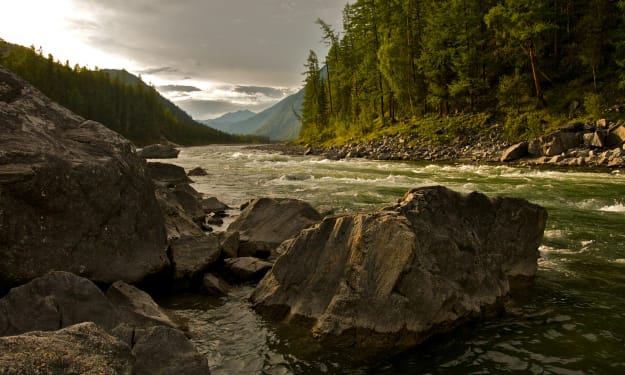The covered up 'bird's home' city that Alexander the Incomparable couldn't overcome
Travel

Alexander the Incomparable attempted to vanquish Termessos however fizzled. Today, the staggering abandoned remains of this once-strong city, roosted like a sustained falcon's home high in the mountains of southwestern Turkey, can be vanquished by anybody able to make the climb up here.
In any case, scarcely any individuals at any point do.
Termessos stands vacant. A terrific archeological gem, protected in separation, seen simply by a couple of modest bunches of individuals who make the excursion from the ocean side retreats of neighboring the travel industry problem area Antalya.
That is a disgrace for the people who pass up a major opportunity. For the individuals who really do get to investigate, it's a significant reward. They get to meander around quite possibly of Turkey's most amazing old city without anyone else.
It's a position of mind boggling air: history and scene; perspectives and quiet; nature and obliteration - all consolidating to make one of the Mediterranean's extraordinary unrecognized archeological marvels.
Here, gradually being gulped by vegetation and worn out by time, are huge catacombs, tremendous underground storages, sanctuaries, forcing city walls and a stunning venue roosted, as Machu Picchu, on a peak that offers sees extending for a significant distance all over.
Notwithstanding its vacancy, Termessos is not difficult to reach. It just requires close to 45 minutes to drive from Antalya's traffic-growled midtown to the entryways of Mount Güllük-Termessos Public Park - a safeguarded untamed life sanctuary that encompasses the remains.
Subsequent to paying a three-euro (about $3) entryway expense at the recreation area's entry, guests then face an additional 10-minute ride further into the pine and gorse-clad slopes along a curve street that arrives at around 1,000 meters above ocean level.
In the long run the street arises into seemingly a tedious parking area with a public bathroom. This was, as a matter of fact, at one time a giant public square, or commercial center for the city, which in its prime quite a while back would've been clamoring with dealers and residents.
It's here where the Termessos experience starts.
What's more, it starts with death.
Burial chamber marauders
Concealed by vegetation toward one side of the public square are the stone-tossed stays of what was obviously once a great road driving endlessly along the slope. Rather than houses or shops, this was fixed with the burial chambers of Termessos' rich and powerful.
Old stone coffins cut with pieces of information to who they once contained, similar to safeguards and lances for champions, lie dispersed. Some are little, others colossal - offering pieces of information to levels of riches or influence. Some are incomplete, their gigantic platforms indicating what would've been.
Every one of them have been broken into by looters throughout the long term, their walls crushed or covers prised off notwithstanding whenever being locked closed with metal catches. Tree roots and ivy creepers have additionally wound through the stonework.
"The criminals working here were generally excellent at their positions," says Önder Uğuz, an Antalya-based workmanship educator and authorized guide who offers voyages through Termessos, which he's been dazzled by since first coming here as an understudy in 1996 ("It was love at first sight!").
Arriving at the core of the old city includes a difficult climb along a verdant pathway that is a little unpleasant and steep in places. Guests here should be outfitted with solid footwear and alright with somewhat difficult climbing on precarious landscape. In summer, it's ideal to visit right on time before temperatures begin to climb, and bring water.
Before long the lower city walls loom into view - a first indicate how very much shielded Termessos was the point at which it was constructed maybe around the fourth or fifth century BCE, some time before the Romans appeared with the designing abilities that would change the explored parts of the planet.
Which brings up the issue: how did individuals of Termessos make it happen?
Uğuz ignores the idea of any secret here. We're too up to speed in the accomplishments of our mechanical age to see the value in even the fundamental capacities of our far off precursors, as he would like to think.
"You and I, we're nothing without our PCs and virtual entertainment accounts," he expresses (soon after taking a snap for his own Instagram feed). "Remove those and we are vulnerable. Not these individuals. They worked with stone for quite a long time. They had nothing else. Building things like this was what they knew how to do."
Individuals of Termessos were known as Solyms, relatives of Luwians, an old human progress that was spread across what is presently Turkey, however to a great extent ignored by archeological researchers until the beyond couple of many years. Right up to the present day, little is had some significant awareness of the Solyms or when they built their city.
In any case, they obviously understood what they were doing. Their decision of area showed a virtuoso for vital reasoning. In addition to the fact that it was on a significant shipping lane, empowering it to develop rich on products and installments from individuals going to and from the Mediterranean, its elevation and directing perspectives made it simple to guard.
Which is the reason when Alexander the Incomparable appeared around 333 BCE - when Termessos showed up in the set of experiences books - he was clearly unfit to attack or barricade the city into give up, notwithstanding numerous endeavors. He supposedly considered the city an "bird's home."
Afterward, the Romans had more outcome in controlling the city. Not through force, says Uğuz, but rather through additional deceptive means, such as offering independence under Roman "security." "The Romans resembled the mafia," he proposes.
Battle school
Moving higher up the slope on a rough way growing with fragrant wild savvy, there's more proof of how complex life in Termessos would've been. To one side, there's the marble vestiges of the city's exercise center, a sort of school grounds for learner fighters, complete with bathhouse and refectory.
A portion of the fundamental structure is as yet flawless, with signs that noteworthy curves once stumbled into its front wall. Inside were two stories, in addition to an underground vault for capacity. In front is the palaestra, a region that would've been utilized for wrestling and battle preparing and which today is covered with bits of the recreation center's earthenware rooftop tiles.
It is, obviously, for the most part abandoned. Termessos was accepted to have been obliterated by a seismic tremor the specific date of which isn't known, however conceivably the fourth or fifth hundred years. What remains isn't crafted by archeological remaking. It's the authentic express the structure has been left in for the beyond 1,600 years.
Here, the quietness and vacancy of the spot permit the creative mind to meander - resurrecting those fighters and permitting representation of their counterfeit fights in a spot that has changed so minimal after some time.
Further up, the upper city walls give directing perspectives on the woods beneath and offer a decent vantage point over anybody attempting to creep up for an intrusion. Past them is more proof of development.
There are the remaining parts of a covered water seepage framework. What's more, for a city that had not many water sources, they are quite possibly of its most great resource - massive multi-loaded underground storages cut by hand into strong stone and fixed with mortar.
Fit for holding as much as 1,500 tons of water, these huge compartments would've been imperative to the endurance of a city that had not many regular wellsprings of H2O - particularly when Alexander the Incomparable was mounting bars. Today, they're loaded up with broken segments and other rubble, reasonable unloaded there when the city was deserted. There's hypothesis water deficiencies might have been behind a choice to at long last move the city somewhere else.
Extravagance shops
Close by, there's the monumental external mass of the bouleuterion or gathering house that would've been the city's seat of force, another focal public square tracing all the way back to pre-Roman times and the vestiges of a colonnaded road that once housed the city's most select shops.
"This is the Champions Élysées of Termessos," says Uğuz. Like the Parisian upscale retail street, this would've been where the affluent spent their money, he makes sense of. The best olive oils, fabrics, calfskin products and things imported from generally around the Mediterranean would've been discounted here.
These are sideshows to the city's masterpiece fascination: the theater
After a last scramble over tremendous chunks of marble, the view opens up onto a legendary scene of the huge exhibition space, roosted on the city's most noteworthy point.
The setting is amazing, with mountain gorges flowing endlessly on one or the other side. The sheer drop behind the theater's upper walls is confounding. It's a suggestion to be cautious while investigating ruins that haven't been fenced off for wellbeing.
With space for around 4,000 individuals, the semi-circle of stone porches faces the remains of what would've been a phase. The theater presumably originated before the appearance of the Romans, however was subsequently refreshed along Roman lines.
In Termessos, the area is especially critical, as it reclines across from a mountain that was once hallowed to the city's occupants. It's not difficult to see the reason why this was a particularly consecrated spot, with sees that, on dimness free days, stretch similar to the port of Antalya.
Furthermore, once more, it's a spot to sit and envision what life resembled almost quite a while back, when such performance centers would've been involved by the Romans as, as per Uğuz, a promulgation device - a delicate power to hold their domain within proper limits.
As history examples go, this is staggering.
Uğuz (who can be reached by means of email: [email protected]) says he never tires of investigating Termessos. He additionally offers voyages through other more famous archeological destinations nearby, yet the serenity and excellence of this secret antiquated wonder step him back over and over. He especially cherishes absorbing the vistas from the city's upper walls.
"For the most part, I'm staying there with my significant other, under a juniper tree in springtime, a lovely blue sky with this extraordinary landscape," he says, adding that all year, the isolation presented by Termessos is likewise a fascination.
"For me it's ideal. Just you and nature; little squirrels and prehistoric studies. The main thing missing is a cool lager."
About the Creator
Alfred Wasonga
Am a humble and hardworking script writer from Africa and this is my story.
Enjoyed the story? Support the Creator.
Subscribe for free to receive all their stories in your feed.






Comments (1)
Liked it as usual.